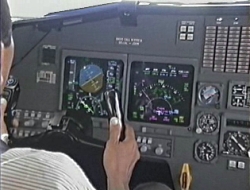
 Flight Controls
Flight ControlsThe flight control systems use conventional and fly-by-wire technology. The five multi-function spoiler panels per wing are powered by fly-by-wire actuators.The aileron control system incorporates a powered control system. The roll spoiler system consists of two spoiler panels per side with the remaining three spoilers providing only speed brake functionality. All spoiler panels provide ground spoiler functionality.The rudder control system utilizes two powered rudder control surfaces. Fly-by-wire technology is utilized to incorporate rudder trim and yaw damp function into the surfaces.The elevator control system utilizes powered actuators.Pitch trim is handled by an electric powered horizontal stabilizer trim actuator.The flap actuation system uses a centrally located electric drive motor, trailing edge drive elements and dual mechanical flap actuators on each panel. A single slat panel per wing is actuated by simple hydraulic actuators that are electrically commanded.
Ice and Rain Protection
The wing leading edge, horizontal stabilizer leading edge and engine inlets are heated by bleed air. Electric heat is used for the windshield, pitot/static systems and engine probes.
Pressurization and Environmental System
Cabin pressurization is supplied by bleed air from eachengine and the APU. An avionics coupled pressurization controller with multiple four 4 inch diameter outflowvalves are set to maintain a cabin altitude of 6,700 ft(2,042 m) at 45,000 ft (13,716 m).
Instrument and Control Panels
The aircraft is designed for ease of operation and features four high resolution 15.1” Landscape Displays interfaced for point and click access to flight planning, aircraft performance monitoring, integrated weather,charts and maps, system synoptics, auto throttle, and functionality for future airspace integration. The ability tointegrate new technology such as HUD, EVS/SVS will be included.
Onboard Maintenance System
The Citation Columbus will incorporate a central Onboard Maintenance System (OMS) to perform airframe and supplier system maintenance and diagnostic functions. The system displays live parameters, performs initiated LRU tests and rigging functions, collects,stores and displays system/component faults,trend/exceedance history and associated data.
This data is viewable through the cockpit display(s) and navigated using normal pilot controls. This functionality will reduce the need for separate diagnostic software and/or hardware (laptops, etc.) during routine troubleshooting.
In addition to the OMS, the airplane will incorporate a fulltime data storage device to collect available and useful data for advanced troubleshooting and analysis.
Training furnished shall consist of the following:
a. Flight training to flight proficiency in accordance with Trainer's standards aimed toward type certification ofthree (3) Captains under applicable Federal AirRegulations not to exceed five (5) total hours for thethree (3) pilots.
b. Flight simulation training to simulator proficiency inaccordance with Trainer's standards but not toexceed seventy-five (75) total hours for all pilots.
c. Ground School training for each pilot and classroominstruction for each mechanic in accordance withTrainer's standards.
A crew shall consist of up to three (3) licensed pilots with current private or commercial, instrument and multiengine ratings and a minimum of 1,000 hours total airplane pilot time and up to two (2) mechanics with A&P licenses or equivalent experience.
Training shall be conducted by Cessna or by its designatedtraining organization.a. A simulator shall be utilized which is FAA certified toprovide training for the FAA type rating.






Nenhum comentário:
Postar um comentário